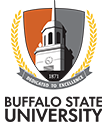Spill Notification, Control Measures and Prevention
As part of its commitment to operating in an environmentally responsible manner, SUNY Buffalo State staff are trained in proper spill prevention and response and spill response equipment are maintained at key locations on campus, including the Clinton Center central Receiving stockroom and the boiler plant.
Here is the procedure to follow to report petroleum or hazardous chemical spills and prevent spill migration into the environment:
1. Report petroleum or hazardous chemical spills to the Facilities Operations and Key Center at 878-6111. For public safety or emergency situations, University Police Department (UPD) may be contacted directly at 878-6333, who will arrange for proper response and clean-up;
2. When reporting a spill or release, indicate the type of material spilled and estimated quantity (if known);
3. If it is a non-hazardous situation, await nearby at a safe distance for the responder's arrival; and
4. Alert bystanders to keep at a safe distance.
Innocuous (non-hazardous) material (e.g. food, beverage) spills at outdoor public areas should be reported to Facilities Operations and Key Center at 878-6111. Innocuous material spills at indoor public areas should be brought to the attention of the building custodial staff.
Campus procedures and measures for spill notification and spill and related pollution prevention and control are provided in the documents posted on the EH&S Policies and Procedures webpage.
Hazardous Material and Petroleum Spill Response and Control Plans
Petroleum and other chemicals are stored on site in various quantities for operation and maintenance of Campus facilities. SUNY Buffalo State has developed an oil Spill Prevention Control and Countermeasures (SPCC) Plan and hazardous materials Contingency Plan, for preventing and responding to campus hazardous material and petroleum releases. The plans are maintained in the EH&S Office.
Steps for Preventing Spills
Here are some simple steps you can take to help reduce spills and your environmental "footprint":
- Check your vehicle for fluid leaks and repair promptly;
- Practice good housekeeping. Keep walkways and work areas neat and orderly. Place litter in trash receptacles;
- Ensure containers are labelled to identify the contents;
- Check and secure containers before transporting; and
- If a liquid container springs a leak, place it into a larger secure container and label the container.

